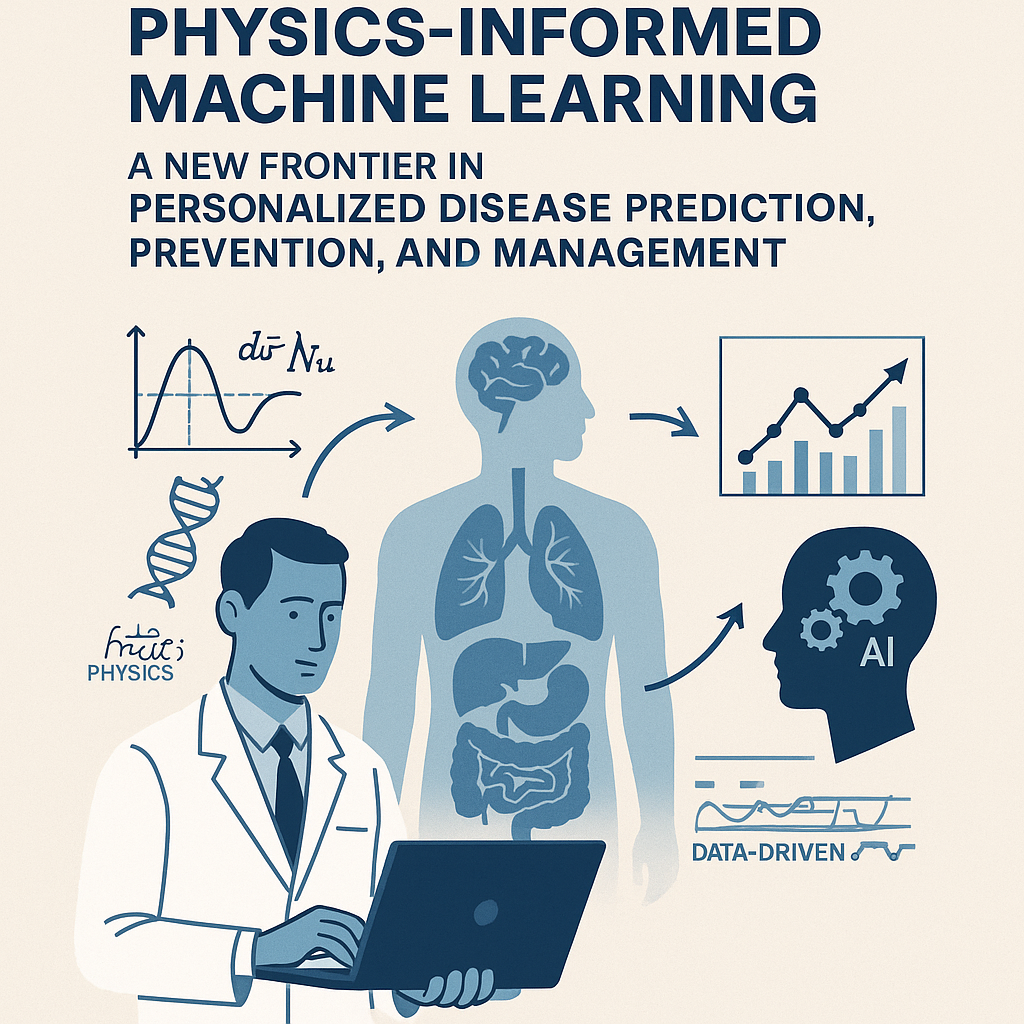
Introduction: Bridging Data-Driven AI and Mechanistic Medicine
Physics-informed machine learning (PIML) represents an emerging paradigm that integrates fundamental physical laws and biological knowledge into machine learning frameworks. This hybrid approach bridges the gap between purely data-driven artificial intelligence and mechanistic understanding, enhancing model interpretability, robustness, and generalizability—qualities essential for clinical application and trust.
Unlike conventional “black-box” models that rely heavily on large datasets, PIML incorporates domain-specific constraints, such as differential equations or physiological relationships, directly into the learning process. In precision medicine, this integration enables models to align with established biological principles while adapting to patient-specific data, improving predictive accuracy across diverse clinical contexts—from medical imaging and hemodynamics to disease progression modeling.
Recent advances demonstrate that PIML can augment sparse clinical measurements with simulated biophysical data, optimize imaging protocols, and predict physiological parameters more faithfully than traditional methods. This article explores how PIML is reshaping personalized prediction, prevention, and disease management by embedding scientific structure into AI models—paving the way for more transparent, efficient, and trustworthy digital health solutions.1,2
What Is Physics-Informed Machine Learning? A Primer for Clinicians
Physics-informed machine learning (PIML) incorporates physical laws—such as fluid dynamics, biomechanics, or physiological systems—into machine learning models to improve performance, especially when data is limited or noisy. Unlike conventional approaches that learn patterns purely from empirical data, PIML constrains models using mechanistic knowledge, thereby enhancing generalization and reducing the risk of overfitting.3
One prominent technique, the physics-informed neural network (PINN), embeds differential equations directly into the neural network’s loss function, ensuring that the model’s predictions remain consistent with known scientific principles. This approach has been successfully applied in various clinical domains: modeling tumor growth using diffusion and angiogenesis laws, predicting cardiac function based on hemodynamic equations, and simulating glucose-insulin dynamics for metabolic conditions.
Hybrid PIML frameworks also combine real-world data with simulations, guiding the model to learn efficiently from fewer examples. For clinicians, this means AI models that are more interpretable, physiologically grounded, and reliable—aligning with the growing demand for transparency and accountability in digital medicine.4,5
Disease Prediction: Enhancing Risk Models with Biophysical Priors
PIML is increasingly being used to improve disease prediction by embedding biophysical priors into AI models, thus enhancing interpretability and performance in clinical settings with limited or heterogeneous data. In cardiology, for instance, PIML integrates patient-specific hemodynamic models into machine learning pipelines to predict heart failure progression more reliably than traditional statistical or black-box models.6
In oncology, models informed by tumor diffusion dynamics and angiogenesis laws have demonstrated superior accuracy in predicting tumor growth and response to therapy. This added mechanistic layer enables finer modeling of tumor heterogeneity and progression, which is particularly valuable in treatment planning and surveillance.7,8
Moreover, in rare diseases—where large, annotated datasets are often unavailable—PIML reduces overfitting by enforcing biologically plausible constraints. By embedding structure into the learning process, PIML facilitates personalized risk stratification and dynamic disease modeling, enabling earlier diagnosis and more precise clinical decision-making. This fusion of mechanistic modeling with machine learning represents a crucial advancement in personalized predictive analytics.9
Disease Prevention: Modeling Dynamics and Intervention Outcomes
Beyond prediction, PIML offers transformative potential in disease prevention by enabling forward modeling of physiological systems and simulation of preventive interventions. By integrating continuous data from wearable sensors (e.g., respiratory rate, heart rate, or glucose monitoring) with mechanistic models of underlying physiology, PIML enables dynamic, individualized risk monitoring.For example, in metabolic diseases, PIML has been used to model insulin-glucose dynamics, offering personalized predictions of dysregulation and informing timely lifestyle or pharmacologic interventions. In respiratory care, integrating physical models of lung mechanics with real-time sensor data allows early detection of decompensation in patients with chronic pulmonary disease.10
At the population level, PIML has improved epidemic forecasting by incorporating compartmental models (e.g., SEIR) into AI systems. During the COVID-19 pandemic, this approach enhanced the accuracy of infection spread predictions and helped policymakers simulate intervention scenarios that balanced health outcomes with economic constraints.11,12
These applications illustrate how PIML can support both individual-level preventive strategies and public health policy, offering a new framework for proactive, data-informed decision-making in clinical and global health contexts.
Reference:
Kissas G, et al. Machine learning in cardiovascular flows modeling: Predicting blood pressure and flow with physics-informed neural networks. Comput Methods Appl Mech Eng.2020;358:112623.
Raissi M, Perdikaris P, Karniadakis GE. Physics-informed neural networks: A deep learning framework for solving forward and inverse problems involving nonlinear partial differential equations. J Comput Phys. 2019;378:686-707.
Raissi M, Perdikaris P, Karniadakis GE. Physics-informed neural networks: A deep learning framework for solving forward and inverse problems involving nonlinear partial differential equations. J Comput Phys. 2019;378:686-707.
Karniadakis GE, Kevrekidis IG, Lu L, Perdikaris P, Wang S, Yang L. Physics-informed machine learning. Nat Rev Phys. 2021;3(6):422-440.
Yang F, et al. Physics-informed neural networks for cardiovascular flow modeling: A review. Front Physiol. 2023;14:1150208.
Physics-informed deep learning for infectious disease forecasting. Sci Rep. 2025 Jan 16; [PMID: 39876937].
Physics-informed machine learning for automatic model reduction in biomedical applications. Sci Rep. 2025; [DOI:10.1038/s41598-025-92680-8].
Physics-Informed Neural Networks Integrating Compartmental Models for COVID-19 Dynamics. Front Artif Intell. 2023; [PMCID: PMC10459488].
Advances in physics-informed neural networks for disease modeling and prediction. Front Physiol. 2023; [DOI:10.3389/fphys.2023.1150208].
Chen Y, et al. Integrating artificial intelligence with mechanistic epidemiological models: A scoping review. Nat Commun. 2025 Jan 10; [PMCID: PMC12030369].
Qian Y, Marty É, Basu A, O'Dea EB, Wang X, Fox S, Rohani P, Drake JM, Li H. Physics-informed deep learning for infectious disease forecasting. ArXiv [Preprint]. 2025 Jan 16:arXiv:2501.09298v1. PMID: 39876937; PMCID: PMC11774452.
Zhang Z, et al. Physics-informed neural networks integrating compartmental models for COVID-19 transmission dynamics. Viruses. 2023 Aug 16;15(8):1749.








Post comments